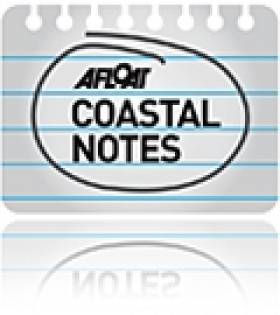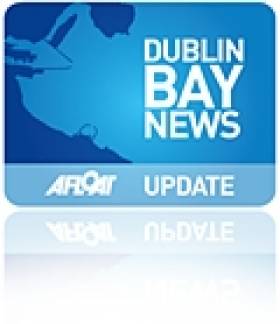Displaying items by tag: Dun Laoghaire Baths
Work is underway at Dún Laoghaire on the €9 million redevelopment of the old Dún Laoghaire Baths site that has been derelict for nearly 30 years.
A contract with SIAC-Mantovani has seen part of the old baths buildings demolished before new facilities are installed including a jetty and other maritime works to increase marine leisure facilities on the east coast.
As Afloat.ie reported previously, the approved plans will see the retention of the existing baths building and include a new pedestrian walkway between the promenade at Newtownsmith and the rear of the East Pier. Proposed new amenities include a small café, public toilets, an artist space, upgrading of the existing maritime gardens and a new jetty for access to the sea for kayaks, canoes and small craft.
Welcoming the redevelopment of the seafront, the Cathaoirleach of Dún Laoghaire Rathdown County Council, Cllr. Tom Murphy (FF) said “this investment will see a rebirth of the area between the East Pier and Newtownsmith, which has been derelict since the old baths closed in 1997.”
Dún Laoghaire Rathdown County Council has signed a €9 million contract with SIAC-Mantovani for the redevelopment of the old Dún Laoghaire Baths site.
As Afloat.ie reported previously, the approved plans will see the retention of the existing baths building and include a new pedestrian walkway between the promenade at Newtownsmith and the rear of the East Pier. Proposed new amenities include a small café, public toilets, an artist space, up-grading of the existing maritime gardens and a new jetty for access to the sea for kayaks, canoes and small craft.
Welcoming the redevelopment of the seafront, the Cathaoirleach of Dún Laoghaire Rathdown County Council, Cllr. Tom Murphy (FF) said “this investment will see a rebirth of the area between the East Pier and Newtownsmith, which has been derelict since the old baths closed in 1997.”
Cormac Devlin, who is a councillor for the area, welcomed the investment in Dún Laoghaire Town saying, “it has been a very long road, the Baths and the Rainbow Rapids closed in 1997 and in the interim several plans have come and gone. They proved unacceptable due to their high-rise nature and unsuitability to the site. This proposal is in keeping with the low-rise built environment surrounding the site and ensures that the site remains in public ownership.”
The Baths were first constructed in 1843, the baths were completely redeveloped by the then Kingstown Town Council in 1910 and operated until 1997 when they were closed.
In March 2010, a report was brought before Dún Laoghaire Rathdown County Council setting out the rationale for the redevelopment of the old Dún Laoghaire Baths site. Councillors agreed the future parameters of development on the site, which included securing the baths pavilion, removing dilapidated structures, enhancing the connection between Newtownsmith and the East Pier and ensuring access to the water’s edge.
The Council made a formal application for a Foreshore Licence to the Department of Environment, Community and Local Government in December 2012. Approval in principle was granted by the Department and Council approval given in March 2015 following a successful public consultation process. In the summer of 2017, the Council erected several information boards on the facade of the prominent Baths building to inform the public of the approved plans for the site.
However the project was delayed when exploratory engineering works found that part of the site formed a retaining wall for Queens Road. This resulted in a significant increase in the estimated cost of the project. In March this year, the Council agreed to fund the renovation as part of an overall €10.3 investment as part of their Capital Programme.
Councillor Devlin acknowledged that a lot of people would have liked to have seen the retention of a public swimming facility on the site, however the proposal includes provision for a jetty which will provide access into the bay.
Councillors Vote To Develop Derelict Dun Laoghaire Baths
The derelict baths site at Dun Laoghaire will be developed following a vote by Councillors to proceed with plans first outlined by Afloat.ie back in April.
The €2.5 million project was given the green light by the Department of the Environment.
The revised plans will see the baths – last used 20 years ago as the Rainbow Rapids – developed into artists' studios with a gallery and café space.
Among other changes, the old saltwater pool space will be filled in to create a green space between the People's Park and the East Pier.
#dlrcc – Dún Laoghaire-Rathdown County Council (DLRCoCo) has tweeted an artist's impression of Dún Laoghaire Baths complete with a new walkway connecting Sandycove to the East Pier and a refurbished Dun Laoghaire Baths building.
DLRCoCo has applied to the Minister of the Environment, Community and Local Government for consent under the Foreshore Act, 1933, to undertake refurbishment of Dún Laoghaire Baths and 'associated works'.
A copy of the application, and the relevant maps, plans and drawings, are available for inspection for the next 21 working days, free of charge, at Dún Laoghaire Garda Station, 34/35 Corrig Avenue, Dún Laoghaire, Co Dublin.
Dun Laoghaire Baths Plans to be Displayed
New plans for the Dun Laoghaire Baths are due to be displayed shortly in County Hall.
Proposals for the project, which is estimated to cost up to €21 million, include the retention and refurbishment of the existing baths pavilion to provide access to swimming and a paddling pool for children.
Also planned is a new structure behind the pavilion with toilet and changing facilities, storage lockers, and a café and restaurant.
Facilities for thalassotherapy (sea water therapy) are also being mooted, as is a proposal to cover the DART line to provide a new forecourt to the People's Park.
For more information visit www.dlrcoco.ie.

































































